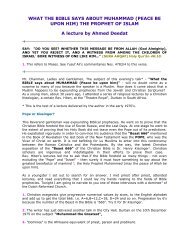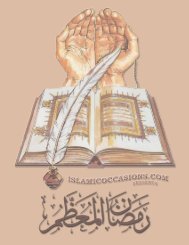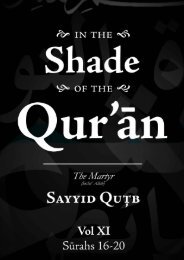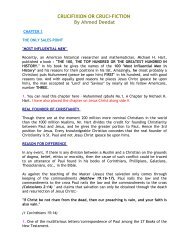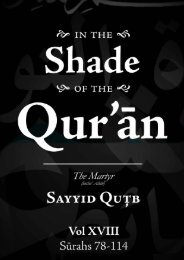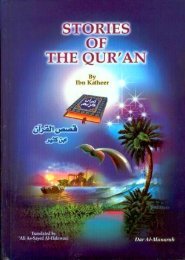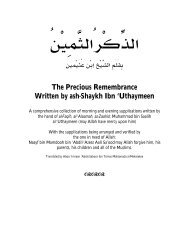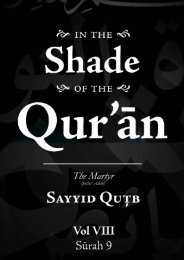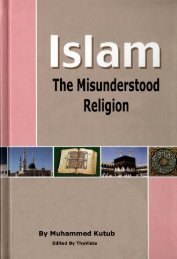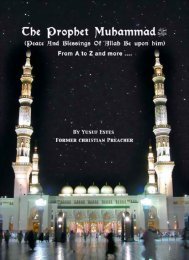Collection Of Articles (Refuting Shia) - Enjoy Islam
Collection Of Articles (Refuting Shia) - Enjoy Islam
Collection Of Articles (Refuting Shia) - Enjoy Islam
You also want an ePaper? Increase the reach of your titles
YUMPU automatically turns print PDFs into web optimized ePapers that Google loves.
The Marriage of umm Kulthoom, daughter of ‘Ali, to ‘Umar<br />
Page 11 of 13<br />
At this point the benefit of investigating the authenticity of the four reports in al-Kafi will become<br />
apparent. It can be seen here that al-Mufid places the responsibility for inventing the marriage of<br />
Umm Kulthoom on the shoulders of the historian Zubayr ibn Bakkar. However, even a cursory<br />
comparison with the narrations in al-Kafi and the one quoted earlier from Tabaqat Ibn Sa‘d (all of<br />
which are but a drop in the ocean) demonstrates clearly that Zubayr ibn Bakkar features nowhere in<br />
any of those chains of narration. Each of the narrators of those reports was a Shi‘i about whose<br />
trustworthiness the ‘ulama of the Shi‘ah were fully satisfied. Not a single on of those reports<br />
originated with Zubayr ibn Bakkar. On the contrary, each one of them is traced back to Imam Ja‘far<br />
as-Sadiq. Al-Mufid’s protestations are thus completely bereft of substance. If anything, it shows the<br />
man’s desperation for finding some grounds, no matter how flimsy or spurious, on which to dismiss<br />
the marriage of Umm Kulthoom.<br />
Aside from trying to make Zubayr ibn Bakkar responsible for the invention of the marriage of Umm<br />
Kulthoom, al-Mufid tries to dismiss the incident by drawing attention to the discrepancies regarding<br />
certain lesser details. A simple response to this is that when a multitude of reports all share one<br />
common element, the common element cannot be dismissed because of differences negligible<br />
details. An objective scholar who is not prejudiced by his idiosyncratic notion of what history should<br />
actually be like will never stoop to the level al-Mufid has. Objectivity here would require thoroughly<br />
sifting through the available historical material and accepting the version that fulfils the criteria of<br />
authenticity, such as have been demostrated in the case of al-Kulayni’s narrations in al-Kafi. If an<br />
historical incident could be denied for a reason as flimsy as discrepancies in minor details, one<br />
could well reject the battle of Badr on grounds of the fact that there are differences regarding the<br />
exact date on which it took place, or differences in the amount of combatants, or even the amount of<br />
persons killed and taken captive. Here we are once again treated to the spectacle of a scholar’s<br />
desperation to superimpose the idiosyncracies of his theology over the facts of history, even if it<br />
means he has to discard the most basic standards of objectivity.<br />
At the end al-Mufid’s nonchalance failed to convince anyone—including himself. Therefore, two<br />
paragraphs after denying the occurrence of Umm Kulthoom’s marriage he comes back to fall into<br />
the queue of traditional Shi‘i scholarship behind people like al-Kulayni and Abul Qasim al-Kufi, and<br />
writes:<br />
Amir al-Mu’minin was coerced to marry his daughter to the man,<br />
because he was threatening and menacing him. There can thus be no<br />
argument against Amir al-Mu’minin because he was forced into it for his<br />
own safety and that of his Shi‘ah. He therefore complied under duress,<br />
just as we say that duress allows for even the pronunciation of Kufr.<br />
Allah says: "Except him who is forced, but his heart is content in faith."<br />
There is no end to one’s amazement at seeing how this man would place the safety of the Shi‘ah<br />
("for his own safety and that of his Shi‘ah") over the chastity and honour of his Imam’s daughter, and<br />
the granddaughter of Rasulullah r .<br />
After al-Mufid<br />
The first explanation produced by al-Mufid—that of denying the historicity of the marriage—was so<br />
ludicrous that he failed to convince even himself. His own student, the eminent Sayyid Murtada<br />
(died 436 AH), brother of the compiler of Nahj al-Balaghah, Sayyid Radi, was even less impressed<br />
by his teacher’s artifices. He solemnly stuck to the line of traditional Shi‘i scholarship, insisting that<br />
the marriage was one of coercion and force. He dealt with the marriage of Umm Kulthoom in two of<br />
his books. In the book ash-Shafi he discussed it at considerable length, the gist of which he later<br />
incorporated into his other book Tanzih al-Ambiya wal-A’immah, where he writes:<br />
As for giving his daughter in marriage, we have mentioned the answer to<br />
this in the book ash-Shafi in detail, and that he only consented to give<br />
his daughter after he had been threatened and menaced and after there<br />
had been altercations at length.<br />
http://islamicweb.com/beliefs/cults/ummkulthoom.htm<br />
1/28/2005



